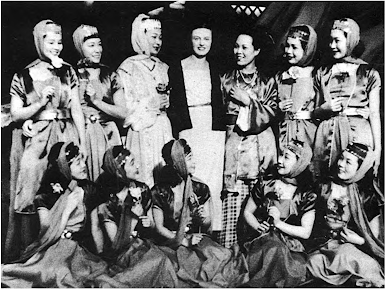Japan Loves Ballet
Russian Ballet companies went on world tours often and one of the countries they went to on the tour was Japan. Japan was extremely enthusiastic about ballet and the dancers and they even had ballet critics who wrote about the different ballets. The ballet dancers themselves were fascinated by Japan, just as Japan was fascinated by ballet.
Prima Ballerina Elena Smirnova husband’s ballet company was the first Russian Ballet Company that toured Japan. In 1916, Smirnova was one of the few ballerinas who danced at the Imperial Theater in Tokyo, Japan. She received amazing praise in Japan.
Prima Ballerina, Olga Sapphire or her Japanese name Midori Shimizu, was a Russian Prima Ballerina in both Russia and Japan. She also was a choreographer and ballet teacher in Japan. In 1936, she moved to Japan with her husband Takehisa Shimizu, who was a Japanese diplomat living in Russia. The Japanese Ambassador suggested to Sapphire and her husband to bring Ballet to Japan. Olga Sapphire is best known for bringing Russian ballet and establishing classical ballet to Japan.
Olga Sapphire was not only the ballet teacher in Japan; she was also the director taking on everything that had to do with stage production. She did this while learning about Japanese language, culture and customs. Olga Sapphire also choreographed Japanese dancing for film. She was the ballet teacher for Nichigeki Dancing Team and worked for the theater company Nippon Gekijo Theater. Her dance partner was Azuma Yusaku who was the pupil of another Ballerina who opened the first ballet school in Japan her name was Eliana Pavlova, no relation to Anna Pavlova.
Olga Sapphire wrote and published three books, Ballet Reader, For Young People Aspiring to Ballet and Ballet: My Life, which her husband translated all three into Japanese. They were very important to the evolution of ballet in Japan. Describing her methods, she wrote about the introduction of ballet to a culture unaccustomed to the art form. Sapphire explained it in a way the people of Japan found interesting and relatable. Nobel Prize winner for Literature, Yasunari Kawabata, wrote about Olga Sapphire’s book, Ballet Reader, in his own book, Dancing girl of Izu, saying that Olga Sapphire had a great impact on ballet as a cultural exchange in Japan.
Some of Sapphire’s pupils were ballet dancers Akemi Matsuo, Junko Matsuyama, Momoko Tani and Toshinko Sato. Toshiko Sato wrote and published a book on Sapphire’s life and honored her by creating events for her for years.
Anna Pavlova was a Prima Ballerina who was also fascinated with Japan. Anna loved Japan and she was fascinated by the culture. She loved the Japanese inns, sleeping on futons and enjoying the hot springs. She had a teacher in Japan named Kikugoro who taught her Japanese traditional dancing that she incorporated into her ballets. Pavlova worked continuously until she mastered the traditional dancing steps; demanding the same discipline of herself in the new dance genre as she demanded of herself in ballet. Pavlova was surprised to find out how much the Japanese already knew about England and their curiosity about it. The cities of Tokyo and Yokohama had ballet performances that non-Japanese ballet fans already commonly attended, some were european and american diplomats. Later, she read the newspapers and discovered her performance was received well by the people of Japan.
As written about in articles, Japanese ballet critics were frustrated by some of the ballet numbers being performed. Anna Pavlova’s Dying Swan performance; however, left them speechless and in awe of the magic of her dancing. They then began to understand what was so fascinating about this particular dancer called Anna Pavlova.
One critic wrote,
“The Dying Swan was beautiful-at least, more beautiful than the Japanese translation of the words ‘The Dying Swan ‘ suggests. Seeing Anna Pavlova dancing, one feels bonelessness before skill. In fact, we Japanese have never seen such a freely flexible body other than that of a boneless man; but, of course, a boneless man is grotesque. The feeling of grotesqueness remained within me; I felt nervous and ridiculous …., However, when I saw The Dying Swan it was strange how the feeling of bonelessness disappeared suddenly. As I gazed upon the arms and legs of Pavlova, the neck and wings of the swan seemed to emerge, accompanied by the wake and ripple of the lake, I even heard the soundless voice-- I could not believe my senses. Pavlova became magnificent. The feeling of decadence remained but I could overlook it. I had seen something beautiful. I could not complain. Pavlova was good.”
- Ryunosuke Akutagawa , Author of The New Stage Art, A Japanese Journal on Ballet.
On September 1, 1923, a 7.9 Earthquake hit Tokyo- Yamagata, Chiba, Kanagawa and Shizuoka and destruction was widespread throughout the Kanto region. In Kamakura the large Buddha statue was affected by the earthquake and was moved by the earthquake’s force. There were 105,385 deaths caused by the earthquake, both Japanese and non-Japanese died. The 1923 earthquake was the greatest natural disaster of Imperial Japan at that time.
Anna Pavlova was worried for her friends in Japan not knowing if they were alive or dead and wanted to give back and help Japan. After the Kanto Earthquake tragedy happened, she turned her ballet evening program into a charitable event for the Lord Mayor’s earthquake fund for victims and the survivors. The program was called ‘Oriental Impressions’. The volunteers who handed out programs wore kimonos. The Japanese Ambassador was touched by Pavlova’s generosity and made a speech and gave her a bouquet of flowers for his country’s gratitude.
It seems both ballet and Japan were always entwined and fascinated with each other. Even to this day, there are ballet schools teaching the art of Smirnova. As more new dancers take the stage, the legacy of Pavlova, Sapphire and their passion for the art continue to grow in Japan.






Comments
Post a Comment